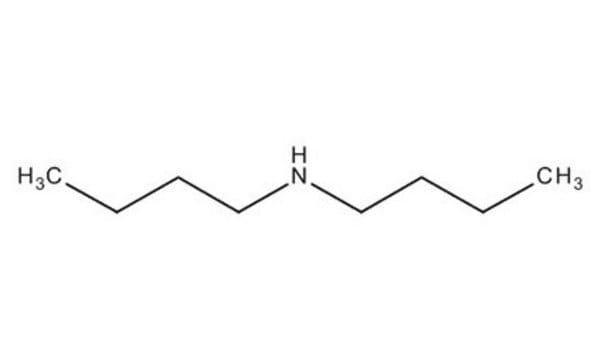34490
Dibutylamine
puriss., ≥99.0% (GC)
Synonym(s):
N-Butyl-1-butanamine, n-Dibutylamine, Di-n-butylamine
About This Item
Recommended Products
vapor density
4.46 (vs air)
Quality Level
vapor pressure
1.9 mmHg ( 20 °C)
grade
puriss.
Assay
≥99.0% (GC)
autoignition temp.
594 °F
expl. lim.
10 %
refractive index
n20/D 1.417 (lit.)
n20/D 1.417
bp
159 °C (lit.)
mp
−62 °C (lit.)
solubility
water: soluble 3.8 g/L at 20 °C
density
0.767 g/mL at 25 °C (lit.)
SMILES string
CCCCNCCCC
InChI
1S/C8H19N/c1-3-5-7-9-8-6-4-2/h9H,3-8H2,1-2H3
InChI key
JQVDAXLFBXTEQA-UHFFFAOYSA-N
Looking for similar products? Visit Product Comparison Guide
Application
Signal Word
Danger
Hazard Statements
Precautionary Statements
Hazard Classifications
Acute Tox. 2 Inhalation - Acute Tox. 3 Dermal - Acute Tox. 4 Oral - Eye Dam. 1 - Flam. Liq. 3 - Skin Corr. 1A
Storage Class Code
3 - Flammable liquids
WGK
WGK 1
Flash Point(F)
104.9 °F - closed cup
Flash Point(C)
40.5 °C - closed cup
Personal Protective Equipment
Choose from one of the most recent versions:
Already Own This Product?
Find documentation for the products that you have recently purchased in the Document Library.
Customers Also Viewed
Articles
Knoevenagel Condensation is an organic reaction named after Emil Knoevenagel. It is a classic C-C bond formation reaction and a modification of the Aldol Condensation.
Our team of scientists has experience in all areas of research including Life Science, Material Science, Chemical Synthesis, Chromatography, Analytical and many others.
Contact Technical Service












